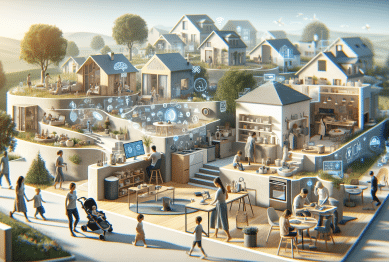Curious about how smart home technology is changing daily life? Discover what’s driving adoption, explore new automation devices, and learn the considerations shaping smarter, more connected living spaces. This article offers a practical guide to the evolving world of smart homes, including privacy, innovation, and the real impact on households.
The Rise of Smart Home Automation
Smart home automation is transforming the daily experience in households worldwide. By integrating devices such as lighting systems, thermostats, and security cameras, people are finding new levels of comfort and convenience. A key attribute of these technologies is their ability to learn preferences and routines, adapting the environment to suit lifestyle needs. The appeal often lies in simplicity: turning off lights remotely, adjusting temperature from a smartphone, and monitoring the premises—even while away from home.
Over recent years, adoption of smart technology has gained momentum thanks to voice assistants and easy wireless integration. Products from major brands now offer compatibility across platforms, making setup more accessible than ever before. Advanced automation enables users to create schedules or scenarios, so lights, alarms, and appliances work together seamlessly. Implementation is not limited to tech enthusiasts; many find the systems user-friendly, with guided onboarding and broad device support.
As the number of connected devices increases, so do possibilities for new home experiences. Some systems can automatically lower shades in response to sunlight, while others sync security alerts with emergency services. Integration even extends to watering gardens or controlling kitchen appliances. These advancements are redefining what it means to manage a living space. The interconnected nature of smart home innovations brings both opportunity and responsibility—in terms of maintenance and choosing secure, reliable platforms for daily use.
How Artificial Intelligence Shapes Your Living Space
Artificial intelligence (AI) is becoming essential in the evolution of smart homes. Devices are moving beyond simple automation; many now use AI to understand human habits and proactively cater to them. Imagine a home that learns when you wake up, adjusts your lighting accordingly, and activates your coffee maker before you even get out of bed. This type of predictive adjustment is increasingly common as sensors and edge computing improve day-to-day life.
Voice assistants are perhaps the most recognizable application of AI in homes. They provide hands-free access to information, entertainment, and device controls, making life more efficient. But AI goes deeper—it analyzes sensor data to optimize energy use, recognize unusual activity, and improve security without constant input. Many systems also offer integrations with third-party ecosystem providers, creating tailored solutions for energy-saving, accessibility, or personal productivity.
These advancements, while promising, come with new questions about privacy and device transparency. As AI collects household data to deliver these conveniences, understanding what is gathered and how it is used becomes crucial. The balance between helpful automation and user control is a leading topic in the industry. Many reputable organizations are guiding best practices for ethical AI design, ensuring homeowners feel confident as technology reshapes modern living environments.
Energy Efficiency and Sustainability Benefits
Energy efficiency is one of the most valued benefits of smart home adoption. Connected lighting, smart thermostats, and energy monitoring devices empower users to minimize power use and reduce overall costs. For many, the immediate draw is the ability to automate daily routines: shutting off heating or cooling while at work, turning lights off automatically when rooms are empty, and tracking appliance consumption right from a mobile dashboard. These features help households make informed choices, promoting both savings and sustainability.
Several studies highlight the environmental advantages of home automation. For example, automated thermostats can cut energy consumption related to heating and cooling by more than 10% compared to manual settings. Water usage is another target area, with smart irrigation systems optimizing outdoor care and reducing waste. The adoption of solar energy monitoring and smart grid integration takes efficiency even further, giving residents insight into real-time consumption and the opportunity to participate in renewable energy programs.
Utility companies and governments recognize these benefits by offering incentives for energy-efficient upgrades. Many regions support rebates for installing certain connected devices, such as smart thermostats or advanced lighting controls. Adopting these solutions not only boosts lifetime savings but also contributes to broader environmental goals. With climate change concerns at the forefront, incorporating energy-wise technology at home is both a personal and collective step toward sustainability.
Privacy and Security in Smart Homes
The convenience of smart home technology comes with important privacy considerations. Since many devices transmit and store personal data, safeguarding information is crucial. Default device settings may be set to share more data than users realize, making it important to review privacy controls immediately after installation. Consumers are increasingly asking for clear policies and transparent data-handling practices before introducing new technologies into the home environment.
Cybersecurity threats, such as hacking or unauthorized monitoring, remain a leading concern among smart home adopters. Good practice involves securing Wi-Fi networks, using strong and unique passwords, and keeping device firmware updated. Some consumers choose systems with end-to-end encryption and advanced user authentication to limit exposure to external risks. Education is key—learning basic digital hygiene helps users stay ahead of security issues.
Industry standards are rapidly evolving to address these challenges at a larger scale. Organizations and standards bodies advise regular audits, security updates, and privacy-by-design commitments from manufacturers. Transparent labeling and easy-to-understand controls are helping bridge the trust gap. As awareness grows, users are encouraged to stay informed and proactive about their digital safety in increasingly connected living environments.
Emerging Trends: Interconnected Devices and New Possibilities
The world of smart home technology is expanding with new interconnected devices, each bringing fresh possibilities for seamless living. Interoperability—the ability for products from different brands to work together—has become a key pursuit among manufacturers. Standardized protocols, such as Matter and Zigbee, are enabling sensors, lights, and appliances to communicate more efficiently, breaking down silos and reducing technical barriers in multi-device homes.
Among these developments, voice control and gesture recognition are helping redefine how users interact with their environments. Appliances, TVs, and even windows can now be managed simply by speaking or moving a hand. This hands-free convenience supports accessibility and enhances independence for individuals with physical limitations. Meanwhile, expansion into sectors such as health monitoring or pet care demonstrates how the smart home can become a holistic support system for the entire household.
Another emerging area involves predictive maintenance and diagnostics. Devices are increasingly capable of identifying performance issues before breakdowns occur, notifying users or even scheduling repairs automatically. This reduces inconvenience and leads to longer-lasting, more reliable appliances. As these trends develop, users gain both peace of mind and more time to enjoy the benefits of a well-managed home.
What to Consider Before Adding Smart Technology
Before investing in smart home technology, there are several key considerations to weigh. Compatibility is essential—devices should easily connect without causing conflicts within the existing infrastructure. Potential users might want to check if the system supports the platforms or ecosystems already in their home, such as voice assistants or security protocols. Reading product documentation and support forums can assist with informed decision-making.
Cost is another important factor. Not all advanced features may be necessary; prioritizing based on personal needs and budget can make the transition smoother and more rewarding. Some might focus on energy savings, security enhancements, or entertainment, depending on their household’s unique routines. Calculating the actual savings from automation, including available incentives from utility companies, can help make a realistic plan that balances upfront costs with long-term benefits.
Finally, users should consider how comfortable they feel about data sharing and automation in the home. Setting clear boundaries, adjusting privacy preferences, and reviewing device permissions are all essential steps. Mastering initial setup and ongoing management increases satisfaction—and peace of mind—when leveraging the possibilities of modern home automation. Staying up-to-date with industry developments ensures households remain both empowered and protected as technology advances.
References
1. U.S. Department of Energy. (n.d.). Guide to Home Energy Management Systems. Retrieved from https://www.energy.gov/energysaver/guide-home-energy-management-systems
2. The National Institute of Standards and Technology. (n.d.). Considerations for Managing Internet of Things (IoT) Consumer Devices. Retrieved from https://www.nist.gov/topics/internet-things-iot/consumer-iot-guidance
3. Consumer Technology Association. (n.d.). Smart Home Ecosystem: AI and Predictive Analytics. Retrieved from https://www.cta.tech/Resources/i3-magazine/ai-and-the-smart-home-ecosystem
4. Energy Star. (n.d.). Smart Home Energy Savings. Retrieved from https://www.energystar.gov/products/smart_home_energy_savings
5. International Association of Privacy Professionals. (n.d.). Smart Home Privacy and Security Risks. Retrieved from https://iapp.org/resources/article/smart-home-privacy-and-security-risks/
6. IEEE Spectrum. (n.d.). Interoperability in the Smart Home: New Standards and Challenges. Retrieved from https://spectrum.ieee.org/interoperability-smart-home









